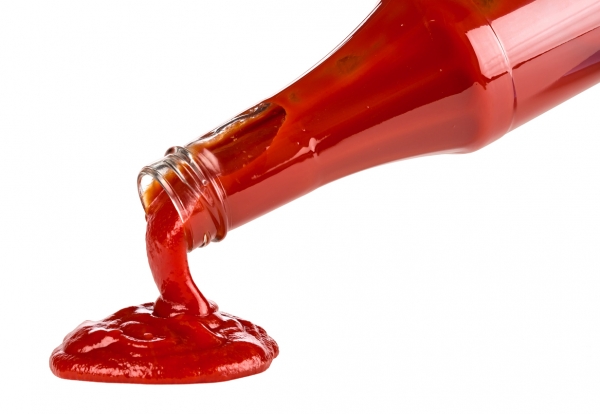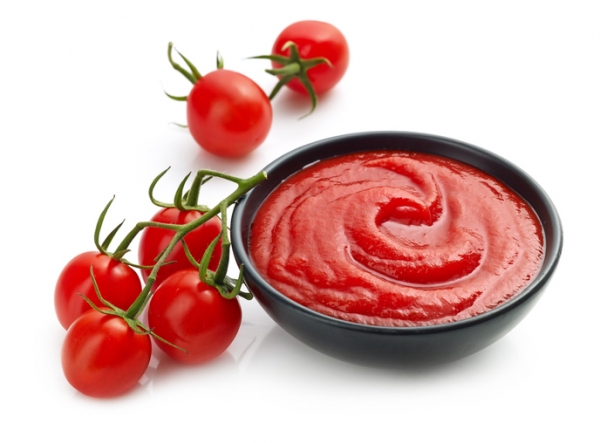Why is ketchup so hard to pour?

Ketchup bottle and ketchup spill (Picsfive, iStockphoto)

Ketchup bottle and ketchup spill (Picsfive, iStockphoto)
How does this align with my curriculum?
| Grade | Course | Topic |
|---|
Ever go to pour ketchup on your fries… and nothing comes out? We’ll let the secrets about the viscosity of this non-Newtonian fluid out of the bottle!
Mmmm. Ketchup. What would hot dogs, hamburgers or french fries be without it? Even if you don’t like ketchup, you probably know people who eat it all the time.
Before the days of squeezable plastic bottles, ketchup typically came in glass bottles (some companies still sell ketchup this way). When you wanted to put some on your french fries you would tip the bottle and wait… and wait… When you finally grew tired of waiting, you would shake the bottle. Or even give it a few good whacks and then all of a sudden there would be ketchup everywhere!

So why doesn’t ketchup flow nicely out of the bottle, like water or juice? It is a liquid… isn’t it? Well, sort of. We’ll get into more about that later.
How do different fluids flow?
The ability to flow is the essential characteristic of a fluid.
Misconception Alert
The terms “liquid” and “fluid” do not mean the same thing. All liquids are fluids, but not all fluids are liquids. Both liquids and gases can flow -- which is what makes them fluids.
Many fluids that you are probably familiar with, like water, gasoline, and cooking oil, flow freely and quickly. But what about when you pour maple syrup or honey? They flow much more slowly. This is because they have a high viscosity. Viscosity is the resistance of a fluid to flowing. The easier a fluid flows, the lower its viscosity. Since honey flows very slowly, it has a high viscosity.

Two factors can impact the viscosity of a fluid:
- Temperature
- Pressure
Sir Isaac Newton (of Newton’s Laws) noticed that when some substances were heated, they had a lower viscosity, and when cooled, they had a higher viscosity. He called these types of fluids Newtonian fluids. Most fluids we deal with on a regular basis are Newtonian fluids. At a given temperature, the viscosity of a Newtonian fluid stays the same, no matter how much pressure is applied to it.
But not all fluids are Newtonian fluids. Some, like mayonnaise, toothpaste, and ketchup, are also affected by pressure. The viscosity of these fluids depends on how hard the force applied to it is (its magnitude) and how long the force is applied (its duration). Fluids that act this way are called non-Newtonian fluids.

What’s so special about ketchup?
Let’s go back to the ketchup bottle. When you open it and turn it upside down, nothing happens -- it doesn’t flow. This is because the ketchup is acting more like a solid than a liquid. Scientists actually call ketchup and fluids like it “soft solids” or “yield stress fluids” because they only flow when the right amount of force is applied.
Did you know?
Rheology is the field of physics that studies soft solids, including many common condiments, as well as paint and industrial applications like sewage treatment and mining.
Ketchup is a soft solid because of its ingredients. Ketchup is made from finely ground-up tomatoes, along with sugar, spices, vinegar, and water. If you look closely, you might be able to see all of the small bits of tomato that make up the majority of the ketchup. There are enough tomato bits that the solid parts are all touching each other. This physical connection of the solid parts gives the ketchup the strength to resist flowing.

What’s the best way to get ketchup to flow?
To get it to start ketchup flowing, you can shake or tap the bottle. If you can apply enough force all at once, the ketchup begins to act like a liquid and flows out of the bottle. At this point the ketchup is actually much less viscous than it was before it started flowing! But be warned -- sometimes it can come out quickly and splatter ketchup everywhere.
A less messy method is tap or shake the bottle gently and repeatedly. In this case, a smaller force over a longer period of time will get you to the same result.
Did you know?
Heinz scientists have figured out that the optimal flow of ketchup is roughly 0.045 kilometres per hour.
But why do both of these methods get the ketchup to flow?
When you tip the bottle, the strength of all the tomato bits sitting together prevent it from flowing. But if you hit the bottle hard enough, some of the tomato bits will shift, which opens up room for more of them to move. With enough force, the ketchup as a whole will begin to flow. Why it works when you hit the bottle gently for a longer period of time is still a bit of a mystery. Scientists and engineers who study soft solids are actually researching this!
Mmmm...researching ketchup. Sounds like a tasty career!
Starting Points
- Do you ever get frustrated when you have to wait for the ketchup to pour out of the bottle? What methods do you use to get it to flow faster?
- If ketchup was a runny liquid would you still use it on your French fries? Why or why not?
- Have you ever had a large amount of ketchup plop out of the bottle onto your food after you have been shaking or tapping the bottle for a while? How did it make you feel?
- Have you ever considered becoming a food scientist? What jobs might a food scientist do?
- How has ketchup bottle technology changed over the years? Explain.
- Explain how allowing ketchup to come to room temperature will increase its flow rate.
- Why do you think some companies continue to put ketchup in glass bottles while other companies use squeezable plastic bottles?
- Other than in foods, where else can you find “soft solids”? (may require additional research)
- Why is ketchup considered to be a “soft solid”?
- What makes other Non-Newtonian fluids like toothpaste and peanut butter behave similarly to ketchup?
- How is the flow rate of ketchup related to the viscosity of this fluid?
- We do not have the technology to actually see what is happening to ketchup particles when flow begins. How then is it possible for us to describe the behaviour of ketchup flow? Explain.
- Are the people who study the physical and chemical properties of foods such as ketchup real scientists? Explain.
- With all of the technological advancements of the 21st century, why do you think scientists still have not figured out what is happening to the ketchup particles when a light force is applied?
- Heinz actually tests the flow rate of its ketchup. If it is too fast, it is rejected for sale. Why do you think they pride themselves in having “slow” ketchup?
- This video and article can be used to support teaching and learning of chemistry, science and technology related to fluids and viscosity. Concepts introduced include flow, fluids, Newtonian fluids, non-Newtonian fluids, viscosity, soft solids and rheology.
- To deepen students' questioning and comprehension skills, teachers could have students participate in a Question-Answer Relationship (QAR) Learning Strategy. Ready-to-use QAR reproducibles for this article are available in [Google doc] and [PDF] formats.
- Teachers could have students participate in a Concept Definition Web Learning Strategy to explore the concept of soft solids. Ready-to-use Concept Definition Web reproducibles for this article are available in [Google doc] and [PDF] formats.
- Students could use a T-chart to identify how Newtonian and non-Newtonian fluids are similar and different?
- Tomatosphere™ (Action Project)
Connecting and Relating
- Do you ever get frustrated when you have to wait for the ketchup to pour out of the bottle? What methods do you use to get it to flow faster?
- If ketchup was a runny liquid would you still use it on your French fries? Why or why not?
- Have you ever had a large amount of ketchup plop out of the bottle onto your food after you have been shaking or tapping the bottle for a while? How did it make you feel?
- Have you ever considered becoming a food scientist? What jobs might a food scientist do?
Relating Science and Technology to Society and the Environment
- How has ketchup bottle technology changed over the years? Explain.
- Explain how allowing ketchup to come to room temperature will increase its flow rate.
- Why do you think some companies continue to put ketchup in glass bottles while other companies use squeezable plastic bottles?
- Other than in foods, where else can you find “soft solids”? (may require additional research)
Exploring Concepts
- Why is ketchup considered to be a “soft solid”?
- What makes other Non-Newtonian fluids like toothpaste and peanut butter behave similarly to ketchup?
- How is the flow rate of ketchup related to the viscosity of this fluid?
Nature of Science/Nature of Technology
- We do not have the technology to actually see what is happening to ketchup particles when flow begins. How then is it possible for us to describe the behaviour of ketchup flow? Explain.
- Are the people who study the physical and chemical properties of foods such as ketchup real scientists? Explain.
- With all of the technological advancements of the 21st century, why do you think scientists still have not figured out what is happening to the ketchup particles when a light force is applied?
Media Literacy
- Heinz actually tests the flow rate of its ketchup. If it is too fast, it is rejected for sale. Why do you think they pride themselves in having “slow” ketchup?
Teaching Suggestions
- This video and article can be used to support teaching and learning of chemistry, science and technology related to fluids and viscosity. Concepts introduced include flow, fluids, Newtonian fluids, non-Newtonian fluids, viscosity, soft solids and rheology.
- To deepen students' questioning and comprehension skills, teachers could have students participate in a Question-Answer Relationship (QAR) Learning Strategy. Ready-to-use QAR reproducibles for this article are available in [Google doc] and [PDF] formats.
- Teachers could have students participate in a Concept Definition Web Learning Strategy to explore the concept of soft solids. Ready-to-use Concept Definition Web reproducibles for this article are available in [Google doc] and [PDF] formats.
- Students could use a T-chart to identify how Newtonian and non-Newtonian fluids are similar and different?
Additional Resource
- Tomatosphere™ (Action Project)
Learn more
Oobleck and Non-Newtonian Fluids (2016)
Video (4:19 min.) from Crash Course Kids that covers the properties of common states of matters, and discusses how non-Newtonian fluids have properties of multiple states of matter.
The Science of Sauce (2016)
A video (1:15 min.) from The University of Melbourne that discusses the property of ketchup and why force needs to be applied to it to help it move. Note that this resource was also used as a reference.
Soft solids and the science of cake (2016)
An article from the University of Cambridge introducing soft solids, and discussing what cake batter and petroleum oil have in common. Note that this resource was also used as a reference.
References
Elert, G. (n.d.). Viscosity. The Physics Hypertextbook.
Hannink-Melbourne, N. (2016, December 21). Rheology. Futurity.
Simonovich, S. (2017, September 14). Understanding viscosity and non-Newtonian fluids will help your ketchup game. Medium.